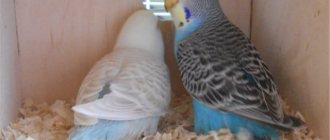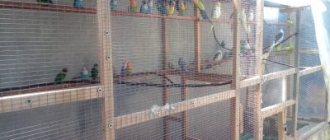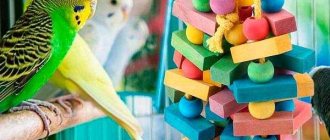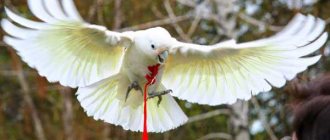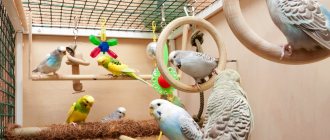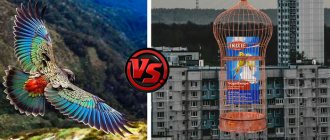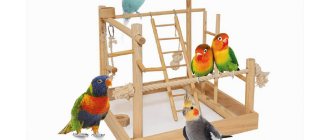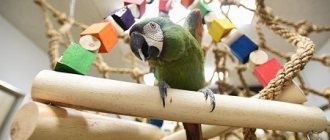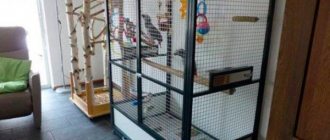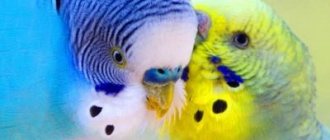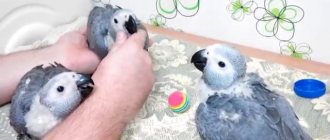Types of perches
Perches (perches, perches) are varied.
| Perches for parrots | ||
| Artificial | pros | Flaws |
| Plastic | They are easy to wash and clean, so they are recommended when the parrot is sick, when complete disinfection is required. | • Cannot be used daily. • Parasites grow in cavities. • Provoke the formation of calluses. |
| Rubber | • Change shape if necessary. • Suitable for walking areas. | The dye and other chemical components in the composition may pose a threat to the health of the feathered pet. |
| Braided from cotton threads on top and with wire inside | • Decorate the interior. • Made from natural cotton material. | There is a risk that the parrot may clog the crop with threads or become entangled in them. |
| Perch nozzles with sand spraying | • Option for grinding claws. | • Paw skin irritations • Calluses |
| Concrete or cement perches | • Grinding of claws and beak. • Additional additive. | • Cold (there is a risk of freezing feet). • The goiter may become clogged. |
| Additives made of pumice (volcanic stone) | • Only for grinding beak and claws | • Not suitable for sitting. |
| Made or sprinkled with small mineral stones | • Grinding claws and beak. • Additional mineral feeding. • Additional additive. | • Mineral perches are not used for prolonged sitting. |
| Heated perches | • Used for outdoor enclosures and outdoor walking areas. | If a bird pecks at the wire used for heating, it may die from an electric shock. |
| Natural | pros | Flaws |
| From tree branches (selected independently) | An ideal option that provides maximum comfort and recreates the natural environment. | No |
| Wooden perches - factory-made (store-bought version) | If the diameter is selected correctly, they are well suited for birds. | • Requires improvement - it is necessary to scrape out nicks and grooves on the perfectly smooth surface of the branches, otherwise the bird will feel pressure on the limbs. • They do not have bark, which helps to wear down the beak. |
Selection criteria
When choosing a perch for a budgerigar, you should definitely clarify the method of attaching it. On sale you can find ordinary blocks that you have to polish yourself. While more expensive solutions offer several mounting options. more critical characteristics are the size of the perch and the material.
Is it worth getting a parrot?
Not really
Diameter
For adult budgies, the diameter of the crossbar should be around 15-18 mm. If young animals are planned to appear in the cage, then it is necessary to take care of 8-10 mm perches. It’s good if the crossbars in the cage are of different diameters, then the bird itself will choose the best option for it.
Material
Flat designs should be avoided. Parrots need to sharpen their beaks and claws, so it's best to look towards abrasive materials. But the main thing here is not to overdo it, otherwise the sharp crumbs can injure the skin on your paws. In addition to perches for sharpening beaks and claws, regular perches should be installed. In this case, heat-saving materials such as wood are suitable.
You should never use toxic products - only environmentally friendly ones. It is dangerous to install household plastic or other similar synthetic material into a cage.
In the hot summer months, when the product begins to emit fumes under the influence of high temperatures, the pet may be poisoned.
Why do parrots need perches in a cage?
The poles perform a number of functions necessary for the normal functioning of parrots:
- Act as an overnight stay.
- They are part of the daytime pastime.
- They help to grind down the claws and beak.
- They help birds develop their paw muscles.
For each type of parrot, the types of poles are selected individually.
It all depends on the following aspects:
- number of birds in the cage;
- the size of the bird (the diameter of the perch should be such that the parrot can clasp it well with its toes, and the bird does not experience any discomfort).
Choosing the right cage for a budgie: what to look for?
So, what should a budgie's cage be like?
The main points to consider when choosing a house for a parrot are to follow:
- The shape of the house is round/oval, rectangular/square, irregular in shape.
- Dwelling size.
- Cage material, distance between bars.
- The pallet and its flooring are sand, paper, sawdust, hygienic fillers, linoleum, plastic.
- Accessories – perch, mirror, feeder, toys.
Don't fill all the free space in your house with accessories. By placing a lot of toys in the cage, you will certainly show your friends that you love your pet, but think about whether it will be comfortable for him to move around such a filled space?
Correct placement of perches in the cage
Perches are placed based on the following rules:
- For 1 bird you will need 2-3 pieces.
- The bird's paw should wrap 75% around the pole.
- Perches should not interfere with free movement.
- They are not mounted exactly on top of each other, so as not to get dirty with droppings.
- They are located at different levels (one for sleeping higher - the parrot should not touch the ceiling with its head, and others lower - so as not to touch the bottom with its tail).
- For frequent walking, some of the poles are attached from the outside of the cage - on the roof or on the side wall.
- When several feathered pets live, their perches are placed taking into account that the birds do not touch each other.
Try changing the position of the poles sometimes. In most cases, parrots like such changes and sometimes even cause delight. As an option, hang the poles separately in the room, make a stand out of them, a swing in a cage, or a kind of toy.
How to care for chopsticks
The crossbars must be periodically washed, disinfected, and, if necessary, replaced with new ones. This is especially true for perches made with your own hands. You can wash the sticks with regular dishwashing detergent.
If bird excrement has accumulated on the crossbars, you should use a brush with metal bristles. You can disinfect either with boiled water or with specialized means. The latter are sold in pet stores and pharmacies.
It’s good if there are two sets: while one set dries after processing (2-3 hours), the other is installed in the cage. Otherwise, you can replace soaking in water with baking in the oven: 20 minutes at medium temperature is more than enough.
Disinfection should not be carried out near a pet's cage. Birds are extremely sensitive to aggressive industrial agents and are especially susceptible to chemical poisoning. The procedure can be performed in the bathroom, on the balcony or veranda.
Which poles should not be used?
For constant pastime, it is strictly forbidden to use the following types of poles:
- Made of plastic;
- From pumice;
- Flexible rubber;
- Threaded cotton;
- Made of concrete.
The use of the above perches is permissible only as a temporary accessory during disinfection or as an additional seating area in places where birds rarely visit.
The wooden options that are offered in the store are used only after additional processing (notching), since they have a smooth, even surface that is not suitable for birds.
Multi-colored budgies
It is also unacceptable to use additives made from prohibited tree branches or store-bought versions of questionable production with damaged packaging.
Branches lying on roadsides or in landfills should not be used. It is also prohibited to cut branches from trees that have been sprayed with chemicals. In both cases, neglecting this recommendation poses a threat to the health of the bird.
What are they needed for
It is known that in the wild, parrots live in thickets of bushes and trees, so the most natural perch for them is a tree branch.
Modern cages are often equipped with plastic slats, which make it difficult and uncomfortable for the parrot to sit and hold on, which can even lead to deformation of the paws, the appearance of ulcers and calluses. In addition, birds tend to sharpen their beaks and often do this on a perch - of course, plastic is not suitable for these purposes and can even be hazardous to health.
That is why it is recommended to place wooden sticks in the cage for the bird to sit on, or to use the most common branches of certain trees as perches, securely fastening them between the rods. Also, natural wood contains a lot of useful substances, which, when consumed, strengthen the pet’s immune system.
Did you know?
In Australia, there is an unusual phenomenon: from time to time, whole flocks of parrots fall from the sky.
This is due to the fact that birds regularly eat the plant, which causes a state similar to intoxication and a temporary loss of coordination. Many manuals on breeding ornamental birds contain information that the parrot can be given branches of any fruit trees. However, this is not true - some trees can harm your pet, so you need to know exactly which branches will be safe and which ones are best avoided, and why.
What trees can be given
First of all, it is important to know which plant branches are best placed in a parrot’s cage. Permitted plants include most deciduous trees:
- Apple tree;
- alder;
- willow;
- rowan (the bird can be offered not only wood, but also the fruits of the tree);
- Linden;
- plum;
- aspen;
- Walnut;
Important! Walnut twigs should be given to birds without foliage, since it contains a large amount of tannins, which are dangerous for the pet.
- cherry (these branches can be given constantly, just make sure that there is no resin released on them);
- plum;
- apricot;
- birch.
Which ones are not allowed?
The list of plants prohibited for consumption by pet parrots is relatively small; the restrictions are mainly related to the presence of tannins in their bark:
- pear;
- poplar;
- bird cherry;
- acacia;
- lilac (it contains a substance called syringin, which has the structure of needle-shaped crystals and, if it enters the digestive system of a bird, can cause severe poisoning).
Did you know?
The natural color of the well-known budgerigar is green, and representatives of the breed with yellow and blue colors were bred artificially.
It is worth noting that tannins (tannin), despite the restrictions, must be present in the diet of parrots in small quantities, since they contribute to better absorption of vitamin C and are a powerful antiseptic. In wildlife in green thickets, these birds often eat branches containing tannin, then compensating for its excess by consuming clay.
How to make perches for parrots with your own hands
DIY wooden poles are the best option for parrots. Making them is quite simple if you read the step-by-step instructions and take into account the advice of experienced poultry farmers on selecting and using the right material.
| Tree branches | |
| Authorized for use | Strictly prohibited |
| • Cherry • Apple • Plum • Citrus • Raspberry • Viburnum • Currant • Linden • Hawthorn • Hornbeam • Beech • Aspen • Ash • Rowan • Sea buckthorn (without thorns) • Birch • Maple • Willow • Alder • Walnut (without leaves) | • Oak (contain tannins) • Pear (contain tannins) • Bird cherry (lots of tannins) • Poplar (absorbs toxins from the air) • Conifers (lots of toxic resins) • Lilac (lots of toxic compounds) • Elder (causes severe distress) Gastrointestinal tract) • Acacia (contains bird poisons) • From the coffee tree (high caffeine content) |
It is recommended to cut or saw off branches, but not to break them. After cutting, the scar on the tree should be treated with garden varnish.
The optimal time of year to collect twigs is late spring, summer or early autumn.
Acceptable Materials
Birds love to chew on perches, toys and twigs.
To prevent toxic substances from entering the body, the parrot's cage must be made of safe materials. Cheap house models made from materials of dubious quality threaten the health of pets. Galvanized rods can cause poisoning to a parrot. No less dangerous is copper, which quickly oxidizes. Its oxides act as a strong poison on birds.
Wooden parrot cages are only suitable for temporary housing. Budgerigars gnaw through them with ease. Wood absorbs moisture, becoming a favorable environment for the growth of bacteria.
A good option is a plastic structure. This material is non-toxic, but is susceptible to high temperatures. Therefore, houses made from it cannot be washed with hot water.
What a perfect nest it is
The best materials for making a bird house (box) are wooden plywood, board or chipboard. You will need four planks for the walls, as well as a pair for the floor and ceiling. In one of the boards it is necessary to make a hole for the entry of birds (entry), the diameter of which should be at least four centimeters (like a small mirror).
The socket does not require additional lighting, which means that it does not need to be equipped with lamps. Do not place the cage with the box in a draft or in the cold, as the birds may catch a cold.
A do-it-yourself nest can be of three types: vertical, horizontal or combined.
Trees and shrubs useful for birds
In the recipes of traditional healers, in addition to flowers and fruits, you can often find stems, branches and bark. Some substances necessary for the body are contained in them in greater quantities than in berries and fruits from the same tree. For a pet, a parrot perch made from a branch of a tree or shrub that is useful for it can become a source of vitamins and a place of natural habitual rest.
You need to know which branches are suitable for a budgie
Under natural conditions, parrots often eat bark from trees on which they rest, roots and leaves, even if there is a sufficient amount of seeds and fruits.
For a parrot, branches need to be cut from certain types of trees and shrubs and carefully prepared.
Budgerigars love to walk along the bottom of the enclosure. They will be happy to find a few twigs there to chew on. Also, to charge the birds, which are habitually mobile by nature, they need to attach branches to the walls of the cage from the inside. The bird should reach them, stretching out to its full height, but without straining too much.
Small twigs can be placed on the bottom of the enclosure, as parrots love to walk
Branches for parrots are as necessary as sepia and fresh fruit. They contain fiber and vitamins that birds cannot get from seeds and fresh produce. The Budgerigar's beak has a notch at the end. They need constant work, chewing on something hard. It is this unsatisfied need that makes your pet chew baseboards and tear wallpaper.
What branches can be given to budgies and where to get them. You can cut branches from fruit trees:
Some shrubs in your garden are also suitable for “gnawing”:
You can choose an apple, plum or apricot branch for your pet
You should not cut branches in places with poor ecology, near roads, factories, places where waste accumulates and near septic tanks. Having a picnic in the forest or picking mushrooms, you can take a few minutes to cut a few twigs or pick up a large dry one. Suitable for a parrot in a cage:
What branches can be given to parrots, raw or do they need to be prepared? Freshly cut branches should not be given to parrots. First they need to be dried a little, then processed. Remove all thorns, remove moss, dirt, and fungal growths. The peeled branches should be placed in water for 10–12 hours. After this, soak in boiling water or heat in the oven for 5 - 10 minutes, depending on the thickness. The bulk of mites and fungi die at a temperature of 60 degrees. When treating bird toys and sticks, it is better to play it safe and raise the temperature. Wood is a good heat insulator. It takes time for the inside of a thick branch to warm up.
Do not wash chews and bird toys with any detergents. As a last resort, use baking soda, and rinse well afterwards with hot and cold running water.
In the bark itself and under it, many microbes, fungal pores, and mites collect. The wood itself may contain various wood-boring beetles, their eggs and larvae. All this can harm the parrot if it gets into its stomach.
Parrots at home catch diseases very easily. Treatment is complex and not always successful. It is better to take care of the cleanliness of toys and food, make the cage correctly and place it in a safe and convenient place for the bird.
Tips for selection and location
Choosing the right perch for a parrot is an important task for the owner. Here are some important rules:
- the main thing is the correct size of the additive. It is ideal when the parrot wraps its paw 75 percent;
- you need to choose a perch so that it protrudes from the cage by 5-7 mm;
- buy several perches at once of different diameters from narrow to wide. With this choice, it will be easier for the parrot to distribute the load on its legs;
- check the fastening. It must be reliable enough to hold the bait well;
- prefer a perch with different diameters along the entire length;
- for the cage you need to buy 2-3 poles. It is important that there is no food or water under them;
- when purchasing, specify what breed of parrot the bait is intended for, this will greatly facilitate the correct choice of model;
- choose the right wood species. It could be birch, willow, cherry, beech or hawthorn. Walnuts, chestnuts, viburnum, linden, plums, currants, and apple trees can also be used. It is important that there is no resin on the surface of the wood.
Perches for medium and large parrots
This is a great place to “walk” your parrot. To prevent the bird from looking for a place in the room where it could perch, you can make it with your own hands from safe wooden branches.
Then cut off the excess parts and make holes for carabiners in each branch of the spear:
Select two small branches, make a hole in the smaller one and use a screw to connect both branches in a T-shape. Wrap the connection at the top with jute rope, and screw in a special fastener at the bottom:
In the T-shaped structure, make a hole for carabiners, on which you can then hang various devices:
You can screw a bolt into the center of the spear, onto which you can attach a bowl made of coconut shell - it will be used as a bathing suit or feeder for parrots:
Connect the rod and the T-shaped structure to each other using a branch, which is secured with screws and will no longer be removable; wrap the connection points with jute:
Then the parrot perch is located in the place where the birds spend a lot of time:
In this video you will clearly see the entire step-by-step master class on how to make a perch for a parrot with your own hands:
» alt=»Perches for parrots, do-it-yourself perches»>
If you don't consider yourself great at woodworking, you can always make a very simple perch for your parrot with a minimum of effort. The main thing is that the tree is safe for health, thoroughly washed and disinfected from possible parasites, and regularly cleaned of droppings. In any case, the pet will happily chew the bark off the branches, and you will need to install new ones. After doing this a few times, you will learn how to make your own perches almost perfect.
